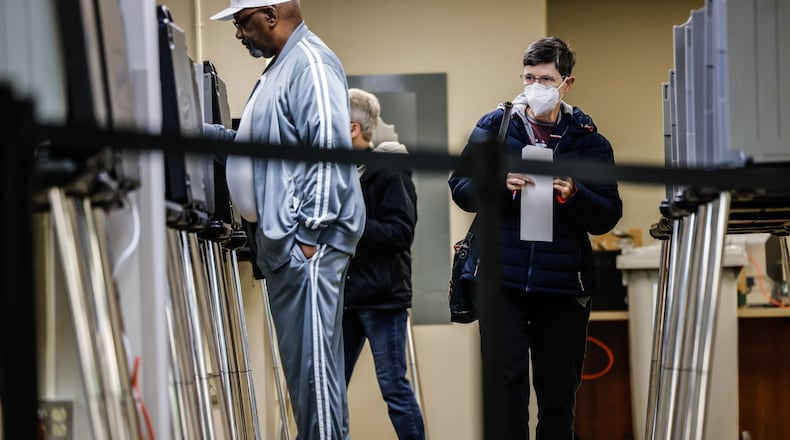The new law requires voters to prove their identity with photo identification when casting a ballot in-person, whether it be on Election Day or while voting early and in-person. Acceptable photo ID includes unexpired driver’s licenses, state ID cards, military ID and U.S. passports.
Ohioans can still cast a ballot in this upcoming primary and special election without a photo ID, as long as they vote absentee. Citizens can both register to vote and vote by mail using only the last four digits of their Social Security number.
“At this point, I’m not sure that everyone understands that a lot has changed,” said Dayton League of Women Voters director Christine Corba. “So what we’re really trying to do is outreach, having things on our website, encouraging questions.”
Major changes
Other notable changes from the law that will impact voter registration and early voting include:
- When registering to vote or updating a voter registration, voters must provide either the last four digits of their Social Security number, Ohio driver’s license, or state ID number. Voters are no longer able to use a copy of a photo ID, a military ID, or any of the formerly valid types of voter ID such as a utility bill, bank statement, government check, paycheck, or other government documents.
- Voters must use the form prescribed by the Ohio Secretary of State when requesting an absentee ballot.
- The timeline for early, in-person voting is changing. The Monday before election day, for example, was removed from the early voting calendar. Hours lost on that day were distributed throughout the week before it.
- The number of drop-off boxes for absentee ballots are limited to one per county. Board of elections offices will also have surveillance cameras for the drop boxes and will be posting footage from the cameras to their websites.
- Absentee ballots must also now be requested a full week before Election Day, as opposed to the previous Saturday by noon.
- Those voters must return their completed ballots within four days of the election; voters previously had 10 days.
Voting absentee? Don’t wait
Corba said the Dayton League of Women Voters always encourages people wanting to vote by mail to make their request for an absentee ballot “sooner rather than later.”
With the shrinking of the timeframes for requesting ballots and sending them off, that message is even more important.
“If you are interested in receiving an absentee ballot, do it now,” she said. “And when you receive that absentee ballot, make sure that you fill it out and return it as soon as possible.”
Corba also advises that voters who mail their ballots watch post office employees postmark their envelopes.
Obtaining ID to vote
The law made Ohio State ID cards free for Ohioans over the age of 17 beginning April 7, but Corba said other barriers exist for people who want to obtain a state-issued ID card.
“There are some assumptions made that getting a state ID is easy,” Corba said. “And it’s not always easy.”
Transportation is an obstacle for people seeking identification necessary to vote in Ohio. Voters who may have misplaced identifying documents also have both a time and cost burden associated with requesting new copies of documents, Corba said.
She said her team is working with another voter advocacy group that recently branched off to Ohio to help people obtain the identification they need or even find a ride to their local Bureau of Motor Vehicles to request an ID card.
VoteRiders, a national organization that connects voters to any resource they may need to cast a ballot, expanded to Ohio after organization leaders began discussing the new law, which critics called one of the most restrictive voter laws in the country.
ID needed to vote in-person
Those who want to vote early, in-person at their local board of election office will need a state-recognized photo ID to cast a ballot.
Nick Ramos, interim Ohio voter ID coalition coordinator, said VoteRiders is working to create volunteer groups in Ohio communities to help people gather the paperwork they need to acquire a state ID card. VoteRiders will cover the costs associated with ordering lost paperwork and even arrange transportation for people who need to order their ID cards.
The group can also help voters request and send off an absentee ballot.
“We want to tailor our help to what is the best decision for that person,” he said.
Ramos said multiple groups are impacted by the change in laws: people experiencing homelessness, domestic violence survivors, the elderly, LGBTQ+ people and more. But making the system more complex impacts all voters.
“We don’t want to make voting harder for everyone,” he said. “We all ought to be seated at the table.”
Local elections boards
Election boards in Montgomery, Clark and Butler counties see thousands of ballots cast early each election season.
During the May 2022 primary election, Montgomery County approved 6,730 ballots that were mailed to them or put into a drop box, whereas Butler approved roughly 2,600 and Clark approved more than 1,600, according to election officials from each county.
Early, in-person voters were also prevalent, with 2,982 ballots cast that way in Montgomery County that election, compared to 4,232 ballots in Butler and 2,165 ballots in Clark.
All three counties saw significantly more people voting by mail during the 2022 general election, which featured state and local races: 38,500 in Montgomery, 21,645 in Butler and roughly 8,000 in Clark.
On Election Day, on average between 1-5% of voters in all three counties used something other than their driver’s license or state ID card to vote.
Butler County Board of Elections Director Nicole Unzicker said her staff and precinct election officials are being trained on the new ID requirements, and a notice outlining the changes will be sent to Butler County voters.
Most of the phone calls her office has received about the upcoming election so far have been geared toward what will appear on the ballot, not about the changes in voting law.
If a voter does not have the required ID to vote early in this election or on Election Day itself, that person will not be turned away, said Clark County Board of Elections Director Jason Baker. Voters also have the option to cast a provisional ballot.
Baker advised voters to also keep in mind that the new law has changed the timeframe in which provisional voters can prove their identity after casting their ballots: voters now have four days to return to election officials with acceptable ID, as opposed to 10 days.
“We surely don’t want voters to be discouraged,” Baker said. “And we would never deny someone the right to provisionally.”
About the Author


